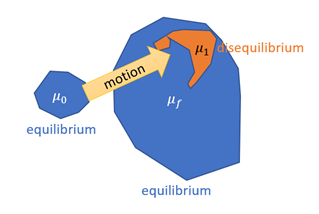This is quite difficult to explain. I would say that this animation is the short explanation. Now I'm getting into the long explanation. This is an extract from a text I have written recently. I use the letter $\mu$ instead of $\rho$ but they mean the same. For me, distribution and macrostate are synonyms. Everything is explained with classical mechanics but I guess the ideas would be very similar in quantum mechanics.
The mechanical transformation of the system is a change in time of the external parameter $V$, a function $V(t)$ defined on some internal $[t_0,t_1]$. The Hamiltonian changes accordingly:
$$H(t)=H(V(t))$$
A system is initially in an equilibrium state $\mu_0$. After the transformation, the system is now in state $\mu_1$. Assume the change is irreversible. $\mu_1$ is not an equilibrium state. According to Liouville's theorem, Gibbs entropy is preserved:
$$S(\mu_0)=S(\mu_1)$$
Why then, do we say entropy increases? Strictly speaking, entropy has not increased yet.
For simplicity, we are going to describe the phenomenon as if macrostates were subsets of the phase space (rather than distributions) like microcanonical ensembles. $\mu_1$ might be a “subset” of a larger equilibrium macrostate. After the transform is finished, the system keeps on following motion on its own, following its natural trajectories at constant energy. Since we assume the system is ergodic, from a given microstate the system can visit any other microstate of the same energy level. Call $\mu_f$ the union of all trajectories intersecting $\mu_1$. If we let the system follow motion on its own, it starts visiting $\mu_f$. When $\mu_1$ is not an equilibrium state:
$$S(\mu_f)>S(\mu_1)$$
The process has somehow two steps:

If you imagine the states as subsets of the phase space, it looks like it:

We said that when the equilibrium is restored, $\mu_1$ becomes $\mu_f$. But what exactly means “the equilibrium is restored”? Is there a true physical reality such as “equilibrium is restored”? An equilibrium state is when our knowledge does not vary with time. But unless we decide to be amnesiac, it clearly does.
Write $f_t$ the Hamiltonian flow (the motion) at $V(t_1)$. At time $t_1$ the distribution is $\mu_1$ and later, at time $t+t_1$ it is $f_t(\mu_1)$. The true distribution constantly changes and because of Liouville’s theorem, it has constant entropy $S(μ_1)$. If we had to describe how $f_t (\mu_1)$ evolves, it sorts of begins to “fill” $\mu_f$ so that at some point, it seems to cover $\mu_f$. No practical experiment will soon be able to tell $f_t(\mu_1)$ from $\mu_f$. The information never disappears but becomes lost in a mess of extreme complexity, so that no realistic experiment can tell the real state from the equilibrium one. The property we just described is unproven. It is a hypothesis stronger than the ergodic hypothesis. In the language of ergodic theory, it is close to a property called mixing. Mixing implies that $f_t(\mu_1)$ becomes a messy shape undistinguishable from the larger $\mu_f$. Something like this:

Theoretically, it is not even true that mixing prevents going back to $\mu_1$ and really justifies what we said. Mixing is only an asymptotic property. Visually, it looks like $f_t(\mu_1)$ fills $\mu_f$ but before $t=+\infty$, it does not provably prevent exploiting the information that we were in $\mu_1$. If a device was capable to revert all atoms velocities instantaneously, we could revert motion back to $\mu_1$. I am not aware of any limitation of mechanics preventing such a device to exist in some way, even if totally unrealistic.



